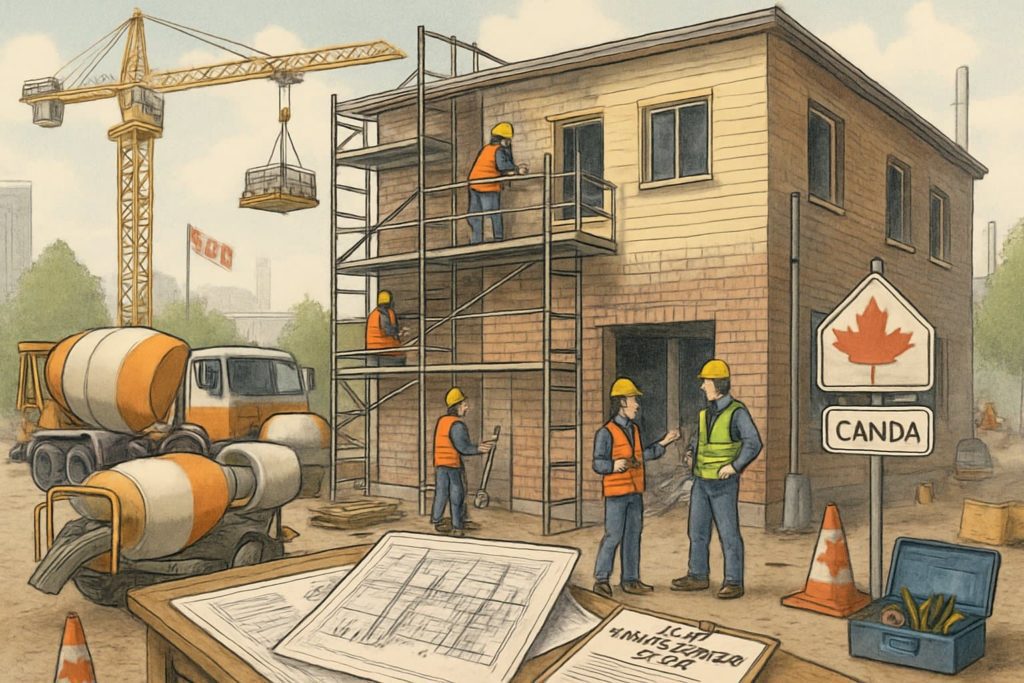Construction bonds play a vital role in Canada’s building industry. They serve as financial protection mechanisms that ensure contractors fulfill their contractual obligations to project owners. These surety bonds create a three-party agreement between the principal (contractor), the obligee (project owner), and a surety company that provides compensation if the contractor fails to meet their obligations.

Many construction professionals in Canada don’t fully understand the different types of bonds available. Some bonds protect against project abandonment, while others ensure quality workmanship or prompt payment to subcontractors. Each bond type serves a specific purpose in the construction process.
The Canadian construction landscape requires these bonds for most government projects and many private ones too. They safeguard investments and create accountability throughout the building process. Knowing which bonds apply to your specific situation can save both time and money while preventing potential disputes.
Bid Bonds: Earning the Project with Confidence
Bid bonds serve as crucial financial instruments in Canada’s construction landscape. These guarantees protect project owners when contractors submit bids for construction projects.
When a contractor places a bid, they must provide a bid bond, typically 10% of the total bid amount. This bond demonstrates their serious commitment to the project.
If selected, the contractor must honour their bid or risk forfeiting the bond amount. The surety company (insurer) would then pay the project owner this sum to cover additional costs of selecting another contractor.
Bid bonds create a level playing field among bidders. They discourage contractors from submitting frivolous bids or withdrawing after winning the contract.
Key Elements of Bid Bonds:
- Issued by surety companies
- Typically, 10% the bid value
- Valid until contract signing
- Replaced by performance bonds after project award
Project owners favour bid bonds because they ensure only qualified contractors participate in the bidding process. Contractors who cannot secure bid bonds often lack the necessary financial stability and experience for the project.
The bid bond process also benefits capable contractors. It eliminates competition from less qualified firms who might otherwise underbid projects they cannot properly complete.
Canadian municipalities and government agencies almost universally require bid bonds for public works projects. Private developers increasingly adopt this practice too.
Contractors should work with experienced brokers to secure appropriate bid bonds. Proper bonding capacity demonstrates professional credibility and opens doors to larger, more profitable projects.
Performance Bonds: Delivering What You Promised
Performance bonds serve as financial safety nets in construction projects across Canada. These guarantees ensure contractors complete their work according to contract specifications.
When a contractor fails to meet obligations, the performance bond activates. The surety company then pays for project completion, protecting the project owner from financial loss.
Key features of performance bonds:
- Typically cover 50-100% of the contract value
- Remain active until project completion
- Require a thorough contractor qualification process
- Protect against contractor bankruptcy or default
Performance bonds differ from bid bonds, which only guarantee a contractor will accept the project if awarded. The performance bond extends further by ensuring proper execution of all contracted work.
Most public projects in Canada mandate performance bonds. Private sector projects increasingly require them too, especially for high-value contracts.
The cost of these bonds varies based on project size, complexity, and the contractor’s financial strength. Rates typically range from 0.5% to 2% of the contract value.
For contractors, maintaining strong financials and project track records helps secure better bond rates. Sureties examine financial statements, work history, and management capabilities before issuing bonds.
Project owners benefit from reduced risk and quality assurance. The rigorous qualification process means only capable contractors obtain bonds, resulting in better project outcomes.
Labour & Material Payment Bonds: Keeping Everyone Paid

Labour and Material Payment Bonds serve as financial safety nets in Canadian construction projects. They ensure subcontractors and suppliers receive proper compensation for their work and materials.
These bonds function as three-party agreements between the general contractor (principal), an insurance company (surety), and the project owners (obligee). If a general contractor fails to pay subcontractors or suppliers, the bond provides a financial backstop.
Key Features of Payment Bonds:
- Typically valued at 50% of the contract amount
- Protect subcontractors and suppliers from non-payment
- Often required alongside performance bonds
- Valid throughout the project duration, plus a claim period
Payment bonds crucially differ from performance bonds. While performance bonds protect project owners, payment bonds specifically protect subcontractors and suppliers.
In public projects across Canada, payment bonds are frequently mandatory. Private projects increasingly require them too, as they reduce payment disputes and liens.
The claim process follows specific steps. Subcontractors must typically notify the surety within a set timeframe (often 120 days after the last provision of labour or materials). Supporting documentation must accompany the claim.
Benefits for Project Stakeholders:
- Subcontractors: Financial protection against non-payment
- Suppliers: Reduced risk when providing materials
- Owners: Fewer project disruptions from unpaid parties
- General Contractors: Enhanced credibility with trade partners
Payment bonds create a more stable construction ecosystem. They ensure that everyone, from electricians to material suppliers, receives fair compensation for their contributions.
Maintenance Bonds: Extending Peace of Mind After Project Close

Maintenance bonds serve as a critical safety net for project owners after construction ends. These specialized bonds guarantee that contractors will address defects or failures that appear during the warranty period.
In Canada, these bonds typically cover a one to two-year timeframe following project completion. This protection ensures contractors fulfill their warranty obligations without additional cost to the owner.
Key Benefits for Project Owners:
- Financial protection against repair costs
- Assurance that contractors will return to fix issues
- Reduced risk during the vulnerable post-completion period
Maintenance bonds differ from warranty bonds in subtle ways. While both provide post-completion protection, maintenance bonds focus specifically on fixing defects that appear after project acceptance.
The bond amount usually ranges from 2% to 10% of the total contract value. Larger, more complex projects often require higher percentages to adequately cover potential repair costs.
Canadian municipalities frequently require these bonds for public works projects. This practice safeguards taxpayer investments and maintains public infrastructure quality.
To claim against a maintenance bond, owners must document the defects thoroughly. Photos, expert assessments, and written notifications to the contractor create a strong claim foundation.
Contractors benefit from these bonds, too. They demonstrate financial stability and commitment to quality work, potentially leading to more contract opportunities.
Supply Bonds: Guaranteeing On-Time Delivery

Supply bonds serve as crucial financial safeguards in Canadian construction projects. These specialized commercial bonds protect buyers when suppliers fail to deliver materials as promised.
The bond creates a three-party agreement between the supplier (principal), the project owner (obligee), and a surety company. If supplies don’t arrive on time or meet specifications, the project owner can claim the bond.
Key Features of Supply Bonds:
- Typically valued at 50-100% of the supply contract
- Cover financial losses due to late or non-delivery
- Protect against supplier bankruptcy or closure
- Include compensation for higher-cost replacement materials
Supply bonds differ from performance bonds, which focus on completed work rather than materials delivery. They’re particularly vital for projects requiring specialized or custom-ordered materials with long lead times.
Many Canadian government and large commercial projects require supply bonds for all material providers. This requirement helps filter out unreliable suppliers and protects taxpayer investments.
For suppliers, these bonds demonstrate financial stability and reliability to potential clients. They can become a competitive advantage when bidding on major projects.
The cost of a supply bond typically ranges from 1-3% of the bond amount, varying based on the supplier’s financial history and industry reputation.
Subdivision Bonds: Meeting Municipal Standards

Subdivision bonds serve as financial guarantees between property developers and municipalities in Canada. These instruments ensure that infrastructure projects meet local regulatory requirements before final approval.
The bonds typically cover streets, sidewalks, water systems, and other essential public facilities within new developments. They protect municipalities from unfinished work or substandard construction that could burden taxpayers.
Canadian developers must secure these bonds before breaking ground on subdivision projects. The value ranges from 50% to 150% of the estimated infrastructure costs, depending on the municipality’s specific requirements.
Key Components of Subdivision Bonds:
- Infrastructure completion guarantees
- Compliance with municipal building codes
- Environmental protection measures
- Public safety standards
- Timeline commitments
Most subdivision bonds remain active for 1-2 years after project completion. This period allows municipalities to verify that the infrastructure functions properly through seasonal changes.
Municipalities may call upon these bonds if developers fail to address deficiencies within agreed-upon timeframes. The bond provider then pays for necessary corrections or repairs.
Developers with strong track records may negotiate more favourable terms. However, first-time developers often face stricter requirements and higher bond amounts due to unproven reliability.
Canadian cities like Toronto, Vancouver, and Calgary maintain specific subdivision bond requirements that reflect their unique geographic and development challenges. Local regulations vary significantly, so developers must research municipal standards thoroughly.
Site Improvement Bonds: For Renovation & Retrofit Projects

Site Improvement Bonds protect municipalities and property owners when contractors undertake renovation or retrofit projects. These specialized bonds ensure that planned improvements are completed according to approved specifications.
In Canada, contractors must often secure these bonds before beginning work on public infrastructure upgrades or commercial property renovations. The bond amount typically ranges from 50% to 100% of the project’s value.
Unlike performance bonds, Site Improvement Bonds focus specifically on the physical alterations to existing structures or sites. They protect against improper installations, code violations, and incomplete work.
Common Applications:
- Heritage building renovations
- Energy efficiency retrofits
- Accessibility upgrades
- Landscape improvements
- Utility infrastructure modernization
Property developers benefit from requiring these bonds as they transfer financial risk to the surety company. If a contractor abandons a retrofit project, the surety must fund completion or pay damages.
Most Site Improvement Bonds remain active for the duration of the renovation plus a 12-24 month maintenance period afterward. This extended coverage protects against defects that might appear after project completion.
Canadian municipalities frequently mandate these bonds for projects involving public spaces or critical infrastructure. The bond serves as both quality assurance and financial protection for taxpayers.
For contractors, obtaining these bonds requires demonstrating financial stability, technical expertise, and a solid track record of similar projects. New contractors may need to start with smaller bonded projects to build their bonding capacity.
Agreement to Bond (Consent of Surety): Prove You’re Ready

An Agreement to Bond (also called Consent of Surety) serves as a critical document in the Canadian construction industry. It demonstrates that a contractor has been pre-qualified by a surety company for project bonding.
This document essentially acts as a promise from the surety company that they will provide the required bonds if the contractor wins the bid. It’s not the actual bond but rather a commitment to issue one.
Obtaining this agreement requires thorough financial scrutiny. Surety companies examine a contractor’s financial statements, work history, and management capabilities before offering this guarantee.
Most public tenders in Canada require an Agreement to Bond with bid submissions. Without it, contractors risk immediate disqualification, regardless of how competitive their bid might be.
Surety agents and brokers play a vital role in securing these agreements. They maintain relationships with multiple surety companies and can match contractors with the most suitable guarantor for their specific needs.
The document typically specifies which bonds the surety is willing to provide, such as:
- Performance bonds
- Labour and material payment bonds
- Warranty bonds
Contractors should contact their surety broker early in the bidding process. This proactive approach ensures all documentation is ready when needed and prevents last-minute complications.
The cost of obtaining an Agreement to Bond is typically included in the broker’s service fees, making it a smart preliminary investment before committing to a full bond purchase.
Choosing the Right Bond for Your Next Project

Selecting the appropriate surety bond for a construction project requires careful consideration of several factors. The right bond protects all parties involved and ensures project completion according to specifications.
Project Size and Scope matter significantly when choosing bonds. Larger projects with higher financial caps typically require more comprehensive bonding solutions than smaller ventures.
Canadian construction companies must assess their specific contractual obligations before selecting a bond. Some contracts explicitly state which bonds are required, while others leave room for interpretation.
Bond types vary in purpose and protection level:
- Bid bonds guarantee that contractors will honor their bids
- Performance bonds ensure project completion per contract terms
- Payment bonds protect subcontractors and suppliers
- Maintenance bonds cover defects after project completion
The surety company’s reputation and financial stability should influence your decision. Established sureties with strong financial ratings provide greater security for construction industry stakeholders.
Consider consulting with an experienced insurance broker who specializes in contract surety bonds. Their expertise can guide you through the selection process based on your specific circumstances.
Construction companies should also evaluate their financial position and bonding capacity. A surety will examine your financial statements, work history, and management capabilities before issuing bonds.
Cost factors include premium rates, which typically range from 0.5% to 2.5% of the contract value, depending on the contractor’s qualifications and bond type.
Remember that bonds are not insurance policies but three-party agreements between the principal (contractor), obligee (project owner), and surety company.
Frequently Asked Questions
Construction bonds play a crucial role in Canadian building projects. These legal instruments provide financial protection and ensure project completion according to specifications.
What are the primary categories of construction bonds utilized in Canada?
Canadian construction projects typically require five main bond types. These include bid bonds, performance bonds, payment bonds, maintenance bonds, and supply bonds.
Bid bonds guarantee that contractors honour their bids and sign contracts if selected. Performance bonds ensure contractors complete projects according to specifications.
Payment bonds protect subcontractors and suppliers by guaranteeing payment. Maintenance bonds cover defects during warranty periods, while supply bonds ensure materials arrive as specified.
How does a performance bond function in the Canadian construction industry?
Performance bonds serve as financial guarantees that contractors will complete projects according to contract terms. The bond involves three parties: the contractor (principal), the project owner (obligee), and the surety company.
If a contractor fails to meet obligations, the owner can claim the bond. The surety may then pay for project completion or hire another contractor to finish the work.
Performance bonds typically cover the full contract value and remain active until project completion. They form an essential part of risk management strategy for large-scale construction projects.
What is the role of a payment bond in the construction sector across Canada?
Payment bonds ensure subcontractors and material suppliers receive proper compensation for their work. These bonds protect against contractor insolvency or payment disputes.
If the primary contractor fails to pay subcontractors or suppliers, these parties can file claims against the payment bond. The surety then investigates and resolves valid claims.
Canadian public projects often require payment bonds under provincial lien legislation. These bonds help maintain project momentum by preventing work stoppages due to payment issues.
Could you elaborate on the necessity of bid bonds in Canadian construction projects?
Bid bonds protect project owners from irresponsible or fraudulent bidding practices. They typically represent 5-10% of the total bid amount.
If a contractor wins a bid but refuses to sign the contract or cannot provide required performance bonds, the bid bond compensates the owner. This compensation covers the cost difference between the winning bid and the next lowest bid.
Bid bonds encourage serious bidders and discourage contractors from submitting unrealistically low bids. They form an important first step in the risk management process for construction projects.
In what situations would a construction company in Canada require a maintenance bond?
Maintenance bonds become necessary during the warranty period following project completion. They typically last one to two years after substantial completion.
These bonds protect owners against defects in workmanship or materials that appear after project handover. If problems arise during the warranty period, the bond covers repair costs.
Maintenance bonds are particularly important for public infrastructure projects like bridges and roads. They ensure taxpayer investments remain protected even after contractors have completed their work.
Can you explain the differences between surety bonds and insurance in the context of Canadian construction?
Surety bonds and insurance serve distinct purposes in construction risk management. Bonds represent three-party agreements (contractor, owner, surety) while insurance involves two parties (insurer and insured).
Bonds expect no losses and require contractors to reimburse sureties for any claims paid. Insurance companies expect and price for potential losses without seeking reimbursement.
Sureties evaluate contractors based on character, capacity, and capital before issuing bonds. This pre-qualification process differs from insurance, which focuses primarily on statistical risk assessment and premium calculations.






